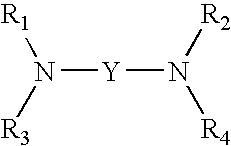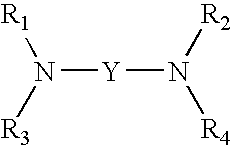Compositions containing N,N,N',N'-tetrakis(hydroxyalkyl)diamine-or N,N,N',N'-tetrakis(hydroxyalkoxy)diamine-based buffers
a technology of hydroxyalkyl diamine and buffer, which is applied in the direction of non-surface active detergent compositions, cleaning compositions, biocides, etc., can solve the problems of tear film and debris, proteinaceous, oily, sebaceous, etc., and achieves rapid disinfection, rapid disinfection of contact lenses, and enhanced
- Summary
- Abstract
- Description
- Claims
- Application Information
AI Technical Summary
Benefits of technology
Problems solved by technology
Method used
Image
Examples
example 1
Preparation of (Hydroxyalkyl)diamine- or (Hydroxyalkoxy)diamine-Based Buffered Compositions
[0049] A test was conducted to study the microbiocidal efficacy of solutions prepared according to the present invention. The test solutions are identified below in Table 1.
TABLE 1(Hydroxyalkyl)diamine- or (Hydroxyalkoxy)diamine-BasedBuffered Test SolutionsIngredients (w / w %)ABCTetrakis111Pluronic F38111Tetronic 908111EDTA00.0250EDTA (no Na+)0.100.1Glycerin1.11.11.1Polymer JR0.020.020.02Trehalose0.20.20.2Alexidine (407 ppm)444PHMB (112 ppm)0.7 ppm00ZnCl20.0500.05Osmolality (mOsm / Kg)218218218pH7.277.167.28
Tetrakis = N,N,N′,N′-tetrakis(2-hydroxypropyl)ethylenediamine
EDTA = Ethylenediaminetetraacetic acid
Polymer JR = Polyquaternium -10
example 2
Biocidal Stand-Alone Testing of (Hydroxyalkyl)diamine- or (Hydroxyalkoxy)diamine-Based Buffered Compositions
[0050] The antimicrobial efficacy of each of the solutions for the chemical disinfection of contact lenses was evaluated. Microbial challenge inoculums were prepared using Pseudomonas aeruginosa (ATCC 9027), Staphylococcus aureus (ATCC 6538), Serratia marcescens (ATCC 13880), Candida albicans (ATCC 10231) and Fusarium solani (ATCC 36031). The test organisms were cultured on appropriate agar and the cultures were harvested using sterile Dulbecco's Phosphate Buffered Saline plus 0.05 percent weight / volume polysorbate 80 (DPBST) or a suitable diluent and transferred to a suitable vessel. Spore suspensions were filtered through sterile glass wool to remove hyphal fragments. Serratia marcescens, as appropriate, was filtered through a 1.2 micron filter to clarify the suspension. After harvesting, the suspension was centrifuged at no more than 5000×g for a maximum of 30 minutes at 2...
example 3
Regimen Testing of (Hydroxyalkyl)diamine- or (Hydroxyalkoxy)diamine-Based Buffered Compositions
[0053] A four-hour no rub and no rinse (NR / NR) regimen using 10 ml of sample solution with a 10 second shaking step (ss) and a four-hour no rub and no rinse (NR / NR) regimen using 10 ml of sample solution with no shaking step (ns) was conducted on Focus™ Monthly (CIBA Vision, Basel, Switzerland) Group IV lenses (Gr IV-A), and tested using Candida albicans ATCC 10231. The test results for the regimens are set forth below in Table 3.
TABLE 3Efficacy of Test Solutions in No Rub / NoRinse (NR / NR) Regimen TestingTEST SOLUTIONABCNR / NR Regimen4 Hr soak / 10 ml / 10 ss (Gr IV-A)Candida albicans (CFU)0, 0, 10, 0, 00, 0, 0NR / NR Regimen4 Hr soak / 10 ml / ns (Gr IV-A)Candida albicans (CFU)ND0, 5, 02, 0, 0
<10 CFU = test passage
>10 CFU = test failure
CFU = colony forming units
ND = no data
[0054] Compositions of the present invention comprising a disinfecting amount of one or more antimicrobial agents, and one...
PUM
| Property | Measurement | Unit |
|---|---|---|
| weight percent | aaaaa | aaaaa |
| weight percent | aaaaa | aaaaa |
| weight percent | aaaaa | aaaaa |
Abstract
Description
Claims
Application Information
 Login to View More
Login to View More - R&D
- Intellectual Property
- Life Sciences
- Materials
- Tech Scout
- Unparalleled Data Quality
- Higher Quality Content
- 60% Fewer Hallucinations
Browse by: Latest US Patents, China's latest patents, Technical Efficacy Thesaurus, Application Domain, Technology Topic, Popular Technical Reports.
© 2025 PatSnap. All rights reserved.Legal|Privacy policy|Modern Slavery Act Transparency Statement|Sitemap|About US| Contact US: help@patsnap.com



